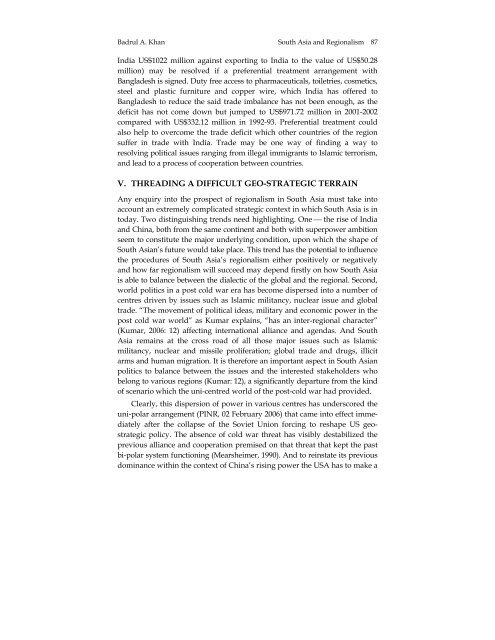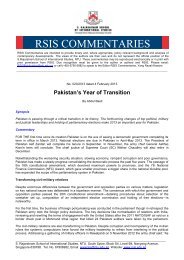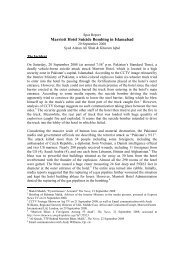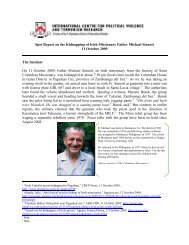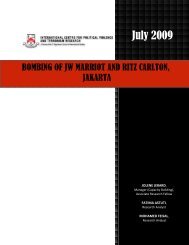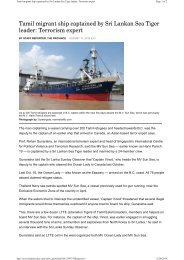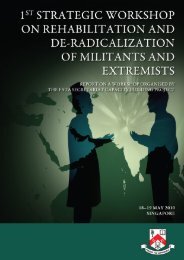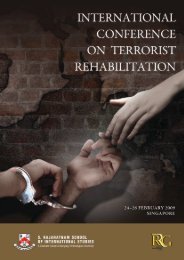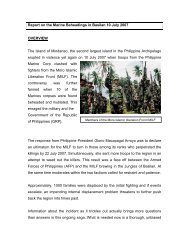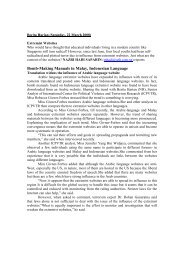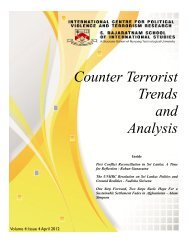Peace and Security Review, Vol.1 No. 2 - International Centre for ...
Peace and Security Review, Vol.1 No. 2 - International Centre for ...
Peace and Security Review, Vol.1 No. 2 - International Centre for ...
Create successful ePaper yourself
Turn your PDF publications into a flip-book with our unique Google optimized e-Paper software.
Badrul A. Khan South Asia <strong>and</strong> Regionalism 87<br />
India US$1022 million against exporting to India to the value of US$50.28<br />
million) may be resolved if a preferential treatment arrangement with<br />
Bangladesh is signed. Duty free access to pharmaceuticals, toiletries, cosmetics,<br />
steel <strong>and</strong> plastic furniture <strong>and</strong> copper wire, which India has offered to<br />
Bangladesh to reduce the said trade imbalance has not been enough, as the<br />
deficit has not come down but jumped to US$971.72 million in 2001-2002<br />
compared with US$332.12 million in 1992-93. Preferential treatment could<br />
also help to overcome the trade deficit which other countries of the region<br />
suffer in trade with India. Trade may be one way of finding a way to<br />
resolving political issues ranging from illegal immigrants to Islamic terrorism,<br />
<strong>and</strong> lead to a process of cooperation between countries.<br />
V. THREADING A DIFFICULT GEO-STRATEGIC TERRAIN<br />
Any enquiry into the prospect of regionalism in South Asia must take into<br />
account an extremely complicated strategic context in which South Asia is in<br />
today. Two distinguishing trends need highlighting. One ⎯ the rise of India<br />
<strong>and</strong> China, both from the same continent <strong>and</strong> both with superpower ambition<br />
seem to constitute the major underlying condition, upon which the shape of<br />
South Asian’s future would take place. This trend has the potential to influence<br />
the procedures of South Asia’s regionalism either positively or negatively<br />
<strong>and</strong> how far regionalism will succeed may depend firstly on how South Asia<br />
is able to balance between the dialectic of the global <strong>and</strong> the regional. Second,<br />
world politics in a post cold war era has become dispersed into a number of<br />
centres driven by issues such as Islamic militancy, nuclear issue <strong>and</strong> global<br />
trade. “The movement of political ideas, military <strong>and</strong> economic power in the<br />
post cold war world” as Kumar explains, “has an inter-regional character”<br />
(Kumar, 2006: 12) affecting international alliance <strong>and</strong> agendas. And South<br />
Asia remains at the cross road of all those major issues such as Islamic<br />
militancy, nuclear <strong>and</strong> missile proliferation; global trade <strong>and</strong> drugs, illicit<br />
arms <strong>and</strong> human migration. It is there<strong>for</strong>e an important aspect in South Asian<br />
politics to balance between the issues <strong>and</strong> the interested stakeholders who<br />
belong to various regions (Kumar: 12), a significantly departure from the kind<br />
of scenario which the uni-centred world of the post-cold war had provided.<br />
Clearly, this dispersion of power in various centres has underscored the<br />
uni-polar arrangement (PINR, 02 February 2006) that came into effect immediately<br />
after the collapse of the Soviet Union <strong>for</strong>cing to reshape US geostrategic<br />
policy. The absence of cold war threat has visibly destabilized the<br />
previous alliance <strong>and</strong> cooperation premised on that threat that kept the past<br />
bi-polar system functioning (Mearsheimer, 1990). And to reinstate its previous<br />
dominance within the context of China’s rising power the USA has to make a<br />
<strong>Vol.1</strong>, <strong>No</strong>.2 2008 pp.77-93


